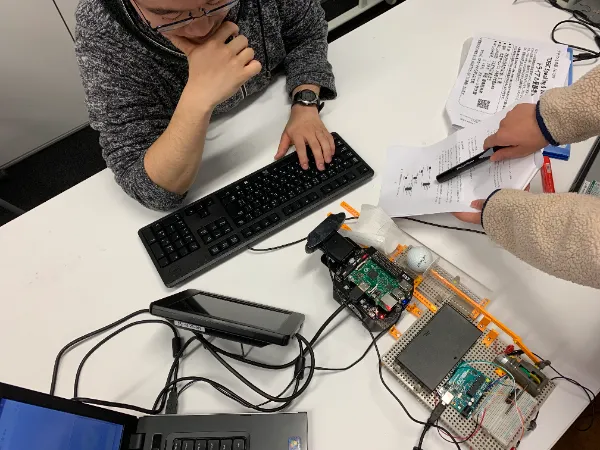

Overview: Social Informatics Design Course
Using data to solve social problems
The complex interplay of real-world problems means that it’s impossible to solve them simply with a single idea. We must first collect all the necessary data and seek solutions based on that data. We also have to propose and implement solutions that consider the diverse range of individuals who make up society. Here, systems thinking is crucial. Take, for example, wildlife monitoring for crops. We need to take a comprehensive approach, thinking about issues such as where and what kind of sensors to install, what monitoring criteria to use, who to notify with what information, and what to do when notifications cannot be addressed, and realizing a system that accommodates all these factors. This requires mastering data science and information processing skills, along with basic knowledge and practical experience in a range of problem domains.
Designing exciting systems
The Social Informatics Design Course primarily focuses on processing a range of societal information and solving problems through systems. It is not just about creating systems, however. Complex social issues like the SDGs require data collection and data-based problem analysis, and our proposals have to both resonate with users and stakeholders and be feasible to deploy out in society. This course covers not only fundamental information and artificial intelligence technologies but also a wide range of methods and techniques for analyzing and solving issues like recycling and healthcare from a social deployment perspective.
Curriculum Overview
The curriculum centers around basic design thinking methodology, data science, and information processing technology. The first year covers foundation subjects, including not only information processing but also fields like mechanics and chemistry that you may need in the future. These must be learned from the first year as it would be too late to study them if they were suddenly needed at a later date. The second-year “Social Problem-Based Learning” is a required course where students learn methods for solving social problems through specific cases. In the third year, specializations come to vary significantly depending on the laboratory. “Social Implementation Learning 1 & 2” are unique subjects taught by multiple faculty members mixing their specialties and can also be taken by students outside those faculty members’ laboratories.
Specialist subjects are primarily software- and intelligence and control-related. As mentioned above, however, because research addresses the whole spectrum of social issues, production engineering and design subjects are also relevant. The Social Informatics Design Course enables students to develop their implementation skills while engaging in learning across diverse academic fields, aiming for highly feasible designs that match reality.
Keywords for Learning
- Pet issues
- agriculture
- healthcare
- bereavement
- regional energy optimization
- stores of the future
- recycling
- local currencies
- continuous health monitoring
- automated production management
- food loss management
- smart agriculture
- design thinking
- artificial intelligence
- data science
- social implementation
- SDGs
- information processing
- programming
- statistics
Imagine
What kind of society do people want next?
Create
Propose: New business and system proposals
Implement: Realization using IT and AI technologies
Evaluate and learn
Analyze SDGs and other issues with data science
Faculty & Researchers
コースデータ
| Degree Awarded | Bachelor of Design Engineering |
|---|---|
| Admission Capacity | 60 students |
| Teaching License | High School Teaching License (Industrial) |
Research Examples
- Development of sorting methods for waste plastic materials using radio waves and light
- Understanding human falling mechanisms and developing preventive measures
- Development of effective monitoring systems to reduce crop damage by wildlife
- Development of digital technologies to give form to memories of the deceased
- Development of support systems for designing appealing robot behaviors
- Development of remote operation interfaces for mobile robots
- Development of programming support methods using machine learning
- Development of information monitoring systems for IoT home networks